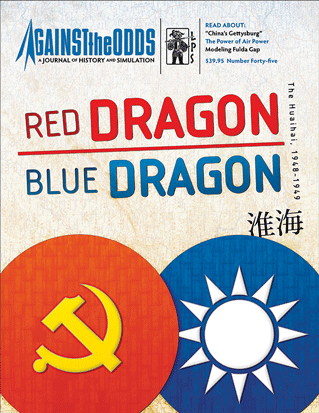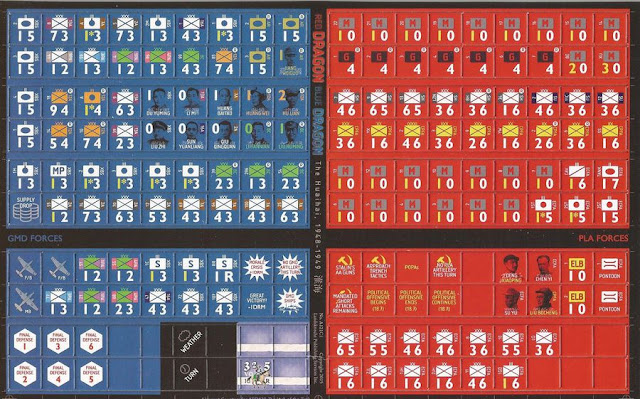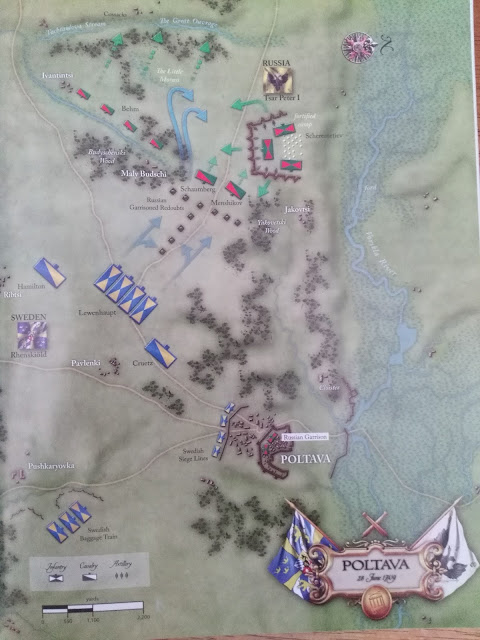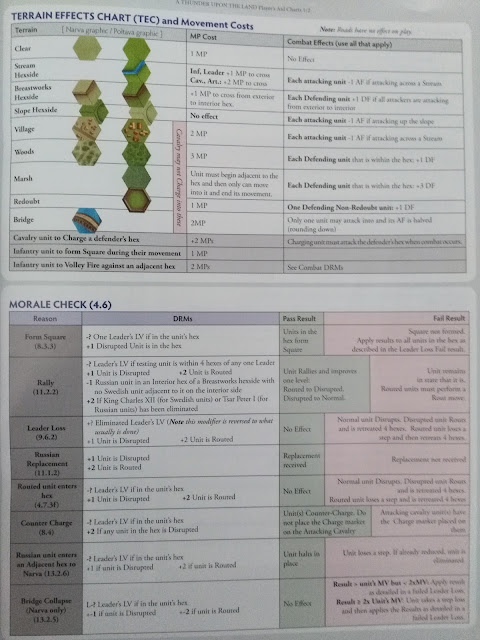Sunday, August 19, 2018
Red Dragon Blue Dragon Against The Odds #45 I have reviewed one other ATO magazine ( http://www.awargamersneedfulthi...
Red Dragon Blue Dragon Against The Odds #45

For your Wargamer, Toy soldier collector, MiniFig collector, military history nut. Reviews, interviews, Model Making, AARs and books!
Against The Odds

I have reviewed one other ATO magazine (http://www.awargamersneedfulthings.co.uk/2018/05/against-odds-magazine-issue-42-with.html). Once again the
ATO magazine is a real stunner. The articles are all well done and very
interesting. The game in this issue is about the campaign for China during the latest Chinese Civil War in
1948 and 1949. This was the last real showdown between the Nationalists
(Kuomintang, GMD) and the Communists (PLA). The game rules use GMD and PLA to differentiate. The background history article is
fascinating reading. One of the facts I was not aware of is how many
American advisors in China were actually more on the side of the Communists than
the Nationalists. This did cost them later when they all seem to have
been caught up in the McCarthy era anti-communist purges after returning
to the US. From a purely armaments point of view, the Nationalists
should have won. Unfortunately for them, the Communists were able to
successfully fight for the hearts and minds of the Chinese people.
 |
| Back of the boxed version |
This is a list of the articles:
Red Dragon Blue Dragon
On Guards: The "China Hands"
Sowing The Wind: The National Air Races 1929-1939
The Fulda Gap Sandbox: Comparing a Hobby Wargame and a
Computer Simulation from the Cold War Era
And The Data Shows On The Move: Kingdoms In Exile
Long Spear, Short Legs: Operational Limitations and
Wintergewitter
The Power Of Airpower
Designing 'Dueling Eagles'
Simulation Corner
As you can see the articles are varied, and they are also well interspersed with pictures and maps.
 |
| Map from the Nationalist side |
The game is an operational one about the Battle of Huai-Hai. This was a fight for the center of China. The Communists had pretty much overrun the North, and the Nationalists had the South. The Communist party had decided that they were ready to capture the strategic city of Xuzhou. The Nationalists have tanks and air support. The Communists are armed with a jamboree of weapons from the Nationalists themselves to captured Japanese ones. Make no mistake, in these battles the Nationalists are the underdog.
 |
| Counters Front |
The map is scaled to twenty kilometers per hex. The game is played in one week turns. The units are mostly Nationalist Corps and Communist Columns. These are anywhere from 15,00-40,00 men. The rules call the PLA Columns Corps for ease. Artillery units represent 36-54 pieces. Armor Battalions are 18-30 tanks. The GMD air units equal roughly 40 aircraft. The actual map portion is small, but it is well done. The small map size allows all of the extras, like the turn track etc, to be on it. The counters are your normal magazine sized counters, but they are well done and easy to read.
Nationalist defection is one of the pivotal parts of the game. The Battle for Xuzhou has been described as the Gettysburg of the Chinese Civil War. The soldiers on both sides of the battle came to about a million men. Oddly enough, considering Korea and Vietnam, the U.S. refused to get involved. So let us look at the game play.
Sequence of play:
Weather Phase
China News! Phase
Interdiction Phase
GMD Movement Phase
Reinforcement and Replacement Segment
FDP Relief Check Segment
GMD Movement Segment
PLA Movement Phase
PLA Reinforcement and Replacement Segment
PLA Movement Segment
PLA Combat Phase
GMD Combat Phase
Turn End Phase
 |
| Counters Back |
One
of the most interesting and innovative rules had to do with one of the
events that can happen when checking the China News Table. This is the
PLA Political Offensive. This Political Offensive lasts for three turns.
During these turns the PLA can move but not attack. They are allowed to
do POPAs (Political Offensive Propaganda Attacks) against the GMD
units. These propaganda attacks can cause the GMD units to defect. This
propaganda offensive actually happened historically. It was caused by a
tremendous amount of casualties suffered by the PLA, and the fact that
the Communist hierarchy (Mao) wanted to win an ideological war.
Historically this was followed by the US shutting off aid to the GMD.
This was really the last nail in the GMD coffin. The flight to Taiwan
was the next step for the GMD after the battle of Huai Hai.
 |
| 'China News Table' |
There
is also an explanation of the seeming change in the names of Chinese
cities and areas in the last fifty years. The difference is that the
older names we were used to reading were from the Wade-Giles system of
translation. The newer Pinyin system is the reason the names changed.
So Peking was Wade-Giles and Beijing is Pinyin. The author of the game's
background piece shows both to help the reader.
 |
| CRT etc. |
In all ATO games there is a side that has their back up against the wall. As mentioned, in this game it is the Nationalist/GMD. Historically the amount of troops that defected from the GMD was large. So playing as the GMD, you have to be ready for anything. It is a tough side to play. The victory conditions are fortunately skewed a bit to help you. The PLA must get a sudden death victory or annihilate the GMD forces. A sudden death victory is if the PLA occupy Xuzhou with a supplied PLA unit on turns one through three. Do not get me wrong, the game does not all go the PLA's way. When the Political Offensive shows up, the PLA player is pretty much hamstrung. As the designer puts it "The Political Offensive can really wreck what seemed to be a victorious PLA campaign. The PLA player needs to be ready for it; it will happen. This means making hay while the sun shines; do not think that you can afford to take a 'slack turn' just because you are ahead (Unless the Political Offensive has already occurred!)"
All in all, a great issue, and a pretty good game about a very unknown (to the West) campaign. The background history of the campaign is stellar.
Robert
Thursday, May 10, 2018
Against The Odds magazine #42 With The Game: A Thunder Upon The Land: The Battles of Narva and Poltava This will be a...
Against The Odds Magazine Issue #42 With The Game: A Thunder Upon The Land: The Battles of Narva and poltava

For your Wargamer, Toy soldier collector, MiniFig collector, military history nut. Reviews, interviews, Model Making, AARs and books!
Against The Odds
The Battles of Narva and Poltava
This will be a two part review. the first part will be about the magazine itself, and the second part will be about the game 'A Thunder Upon The Land'.
I love food, a picture would prove it. However, if given a choice between reading and eating, food for the mind or soul wins every time. Wargaming magazines have been around for about fifty years or so. They have usually been filled with pretty pictures, but we really do read them for the articles. To think of Jim Dunnigan wandering about in his pajamas and a pipe in his mouth is a bit disconcerting. He is, however, our Hefner (I know S&T started earlier, but it really took off under him).
This is my first Against The Odds magazine. I have to save I am mightily impressed. Physically, the magazine is impressive. The maps are especially well done and extremely informative. I have been reading about Charles XII of Sweden for fifty years, so I was very surprised to find new information about him in the background article. I learned that unfortunately Charles XII was an object of hero worship by the Third Reich. The other articles are just as well done as the article about the game history. This will not be my last copy of ATO by a long shot, and I can recommend it to any wargamer.


Magazine wargames have always gotten a bad rap for some reason. I have never understood why. Some of my favorite games, and gaming moments, have come from them. The rules of this game are sixteen pages long. Physically, they are of the same high quality as the rest of the magazine. One excellent part of the rules is that you can take out the two middle pages of the magazine and have a players aid sheet for both players. There are actually two separate tactical games included. One is the Battle of Narva in 1700, and the other is Poltava in 1709. The map is two sided and is large at 22" x 34". I can say it is one of the best magazine maps I have ever seen. The colors and drawings are extremely well done. The counter colors are vibrant, and they are easy to read. The counter attachment to the cardboard sprues and the left over cardboard on the counters is the only thing about the game that is middle of the road.


Narva is either looked at as a master stroke, or the luck of a madman. Poltava is described as a bad piece of luck, or the comeuppance that Charles XII deserved. I believe that Poltava could very well have turned out differently had Charles not been wounded before the battle. Charles had the very bad luck not to have been killed by the bullet that shattered his foot. If he had been killed, his unbroken string of victories would be looked at differently, and Poltava would have been blamed on others.
The Russian Army that you either command or fight with in Narva is nowhere near the Russian Army of Poltava. So the game shows the progress of the Russian military through the years of the Great Northern War.
Tsar Peter I was very busy in his reign. He almost single handedly pulled Russia from the Middle Ages to the eighteenth century. he did this by literally pulling his nobles by their beards as they were kicking and screaming.
The game sequence is as follows:
Initiative Determination phase (on turn one of both games, this is by default the Swedish player)
Activation Phase
Command Activation Segment
Out-of-Command units Segment
End Phase
Replacement Segment
Recovery Segment
Victory Determination Segment
The game comes with zone of control, facing, and command rules. Morale and disruption also play a big factor. These are pretty much what you would expect in a tactical wargame of the early eighteenth century.
 |
| Narva Map |
The player with the initiative uses an AM (Activation Marker) to activate units that have a LOC (Line of Command) to its command leader. This LOC has to be four hexes long, counting the units hex, but not the leaders one. The rest of the AMs are put into a container to be pulled randomly. There is also a 'High Command' AM that is available to each side in the Battle of Narva scenario, but only on the Swedish side at Poltava. This will allow certain listed units to activate once more even though they may have done so with their normal activation marker. In the replacement phase, a unit that does not move or take any other action and is within command range of certain command units, allows the unit to be flipped back to its original strength. The recovery segment is where units that are disrupted or routed can attempt by die roll to rally. Victory is determined by capturing certain hexes, or by unit step loss or leader elimination.
 |
| Poltava Map |
The game has rules for cavalry charges and counter charges. Infantry charges, a Swedish favorite, are also represented in the game. One rule that sticks out is that infantry can form square. From my reading, I believe that historians are still arguing about when the infantry square came into being, so I was a bit surprised about the rule. The game also comes with many optional rules. You can add volley fire to the mix and use it to increase your chances on combat results. There is also a 'Swedish Desperation' optional rule. If the Swedish player has the initiative and is losing the game, he can make a die roll on the 'Desperation Attack Table'. This will show you how many desperate attacks the Swedes can make that turn. One unit in an attack has its attack factor doubled for the attack, but suffers disruption immediately after it. One optional rule that is not really represented is having Charles XII not wounded at the time of Poltava. There is an optional rule to have him appear in the Poltava battle but he does not turn up until turn four. Charles was actually dragged around the battle in a litter, but was not really able to influence the outcome at all. The Swedes saw him as a good luck charm. His military skill and Swedish morale could very well have turned the tide at Poltava.
The rules for the most part are easy to read and understand. The designer Paul Rohrbaugh has been very helpful to people with rule questions on BGG.
The games play out much like in history. At Narva the Swedes attacked in a snow storm, and they were not even supposed to be near the Russians. Charles broke most of the rules of warfare at the time, and in doing so won a spectacular victory. On the other hand, the Russian Army at Narva is brittle and the rules for that scenario help to make it a historical battle. Poltava is thought by some to be completely unwinnable by the Swedes according to most historians. As the Swedish commander, you have to fight through a line of redoubts and then actually attack a fortified Russian camp; and did I mention the Russians have plenty of artillery? Even with Charles able to conduct the battle, it is a very hard task. Under the historical conditions with both Swedish commanders hating each other it is almost impossible. I like these two games. One of the big reasons is that the designer did not fiddle with history to make it more 'gamey', and to give each side a level playing field. The optional rules, if you choose to use them, do add a little more historical flair to the games, but also make it a bit easier at times on both sides.

Unfortunately, the battles of Charles XII and his generals have not really been made into too many games. The most produced game of this war is usually Poltava. I will admit that being of Swedish descent I have always had a love and hate relationship with the battle. For the longest time it was the only battle that you could game, but the situation is a desperate Swedish attack into Russian field works with really no other option. With the Battle of Narva, the Swedes can decide exactly where and when they will attack. The treatment of both battles in this game are first rate, and anyone who is interested in the time period should check them out.
Robert





















Follow Us